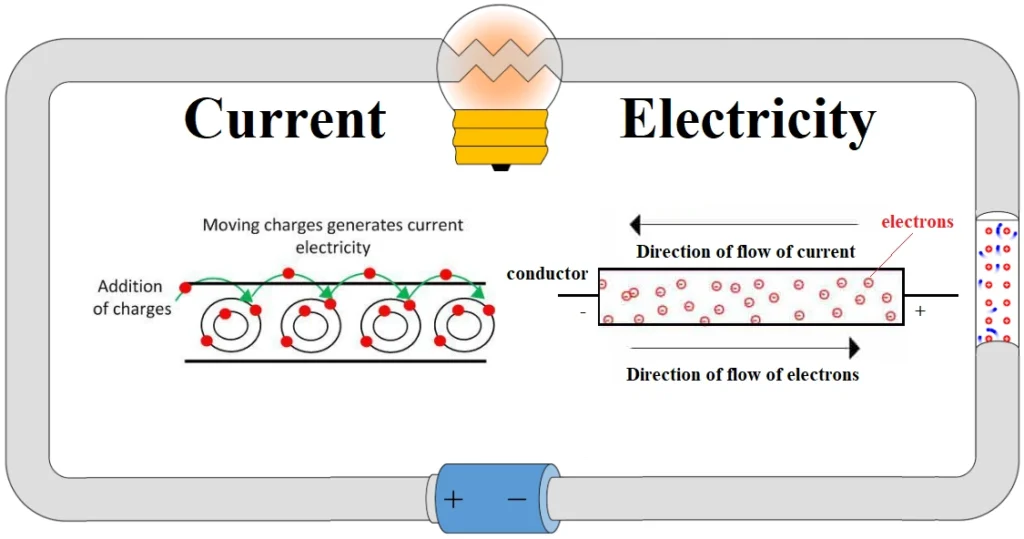Unit – 02 Current Electricity
Current Electricity is the branch of physics in which we study about charge at moving condition.
Electric current:
The rate of flow of electric charge through a conductor is called electric current.
Electric Current, I = Q / t
Where, Q = Amount of charge flowing t = time taken
Electric Current is scalar quantity.
Cause of Electric Current flow:
Electric current flow is the result of a potential difference (voltage) between two points, which causes electrons to move from areas of higher potential to those of lower potential. This movement of electrons enables the transfer of electrical energy and powers various devices.
Table of Contents
Unit of Electric Current:
SI unit of Electric Current is ampere(A).
I = Q / t 1ampere = 1coulomb/1second 1A = 1C/s
Definition 1 ampere: The amount of current flowing through a wire is said to be 1 ampere if 1coulomb of charge is flowing through it in 1 second.
Current is measured by an instrument called Ampere meter(=Ammeter). Ammeter is always connected in series in circuit.
Current Electricity INDEX
| Electric current, flow of electric charges in a metallic conductor | |
| drift velocity, mobility and their relation with electric current | |
| Ohm’s law, V-I characteristics (linear and non-linear) | |
| electrical energy and power | |
| electrical resistivity and conductivity, temperature dependence of resistance | |
| Internal resistance of a cell, potential difference and emf of a cell, combination of cells in series and in parallel | |
| Kirchhoff’s rules, Wheatstone bridge |

Direct Current (DC) and Alternating Current (AC)
Electric current can be further categorized into two types: direct current (DC) and alternating current (AC).
- Direct Current (DC): In a DC circuit, electrons flow in a single direction, maintaining a constant polarity. Batteries and most electronic devices utilize DC power.
- Alternating Current (AC): AC circuits have electrons that periodically reverse their direction due to the continuous oscillation of the voltage. AC power is what we receive in our homes from the power grid.
Difference between AC and DC:
| Aspect | Alternating Current (AC) | Direct Current (DC) |
|---|---|---|
| Definition | Electric current that changes direction periodically. | Electric current that flows in a single direction with constant polarity. |
| Generation | Produced using alternators or generators at power plants. | Generated by batteries, fuel cells, or rectifiers. |
| Waveform | Sinusoidal waveform with alternating positive and negative cycles. | Steady and unidirectional flow of electrons |
| Transmission Efficiency | Efficient over long distances with lower energy losses. | Encounters higher energy losses over long distances. |
| Voltage Regulation | Easily transformed and regulated using transformers. | Voltage regulation is more complex and less versatile. |
| Safety | Less likely to cause muscle contractions, reducing the risk of electric shock. | Can cause muscle contractions, posing a higher risk of electric shock. |
| Stability | Less stable due to its periodic nature. | Stable and constant voltage, suitable for sensitive electronic devices. |
| Applications | Household electricity; electric motors and generators; heating, ventilation, and air conditioning systems | Batteries in portable devices, Electronic circuits and microelectronics, Renewable energy sources like solar panels and wind turbines |
Why is electric current a scalar quantity?
Answer: Electric Current is a scalar quantity because it does not follow the vector law of addition.
MY YouTube Channel Link : 👉🖱 https://www.youtube.com/channel/UCGpC7nWE0-bBv9I53MM8qjQ